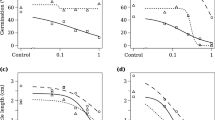Abstract
Aqueous extracts ofNuphar lutea (L.) Sibth. & Sm. leaves (blades plus petioles) and roots plus rhizomes were tested for allelopathic activity using lettuce seedling andLemna minor L. assay systems. The 12.5, 25, 125, and 250 parts per thousand (ppt) treatments of both extracts killed the lettuce seedlings. At 2.5 ppt of extract, radicle growth of lettuce was 29% of the control for leaves and 31% of the control for roots plus rhizomes.Lemna minor frond number was reduced to 34% of the control by the 25 ppt leaf extract and to 43% of the control by the 25 ppt roots plus rhizomes extract.L. minor was killed by concentrations of 125 ppt and above of both plant part extracts. As expected, the frond number and total chlorophyll content measured by theL. minor assay were highly correlated. Osmotic potentials below 143 mOsmol/kg had no influence onL. minor growth. Neither the osmotic potential nor the pH of the undiluted extracts ofN. lutea were in the range known to influence the growth of either lettuce seedlings orL. minor. Nuphar lutea extracts were many times more inhibitory than 16 other hydrophytes we previously examined.
Similar content being viewed by others
References
Ashton, F.M., DiTomaso, J.M., andAnderson, L.W.J. 1985. Spikerush (Eleocharis spp.): A source of allelopathics for the control of undesirable aquatic plants.ACS Symp. Ser. 268: 401–414.
Bell, D.T. 1974. The influence of osmotic pressure in tests for allelopathy.Trans. Ill. State Acad. Sci. 67:312–317.
Buchanan, B.A., Harper, K.T., andFrischknecht, N.C. 1978. Allelopathic effects of bur buttercup tissue on germination and growth of various grasses and forbsin vitro and in soil.Great Basin Nat. 38:90–96.
Cheng, T.-S., andRiemer, D.N. 1988. Allelopathy in threesquare burreed (Sparganium americanum) and American eelgrass (Vallisneria americana).J. Aquat. Plant Manage. 26:50–55.
Cullen, W.P., LaLonde, R.T., Wang, C.J., andWong, C.F. 1973. Isolation andin vitro antifungal activity of 6,6′-dihydroxythiobinupharidine.J. Pharm. Sci. 62:826–827.
Einhellig, F.A., Leather, G.R., andHobbs, L.L. 1985. Use ofLemna minor L. as a bioassay in allelopathy.J. Chem. Ecol. 11:65–72.
Elakovich, S.D., andWogten, J.W. 1989. Allelopathic potential of sixteen aquatic and wetland plants.J. Aquat. Plant Manage. 27:78–84.
Frank, P.A., andDechoretz, N. 1980. Allelopathy in dwarf spikerush (Eleocharis coloradoensis).Weed Sci. 28:499–505.
Godfrey, R.K., andWooten, J.W. 1981. Aquatic and Wetland Plants of Southeastern United States. University of Georgia Press, Athens, pp. 166–167.
Iwanow, A., Wojtasiewicz, K., andWrobel, J. 1986. Sulphoxides of thiobinupharidine thiohemiaminals fromNuphar lutea.Phytochemistry 25:2227–2231.
LaLonde, R.T., andWong, C. 1977. Properties of sulfur containingNuphar alkaloids.Pure Appl. Chem. 49:169–181.
Nichols, S.A., andShaw, B.H. 1983. Physical, chemical and biological control of aquatic macrophytes. Lake Restoration, Protection and Management. U.S. E.P.A., Washington, D.C. pp. 181–192.
Oborn, E.T.,Moran, W.T.,Greene, K.T., andBartley, T.R. 1954. Weed control investigations on some important plants which impede flow of western irrigation waters. Joint Lab. Rep. SI-2, USDA, Bur. Reclam. Eng. Lab., and USDA, ARS Field Crops Branch, pp. 16–17.
Rice, E.L. 1984. Allelopathy, 2nd ed. Academic Press, New York. pp. 285–287.
Salin, M.L., andBridges, S.M. 1982. Isolation and characterization of an iron-containing superoxide dismutase from water lily,Nuphar lutea. Plant Physiol. 69:161–165.
Sutton, D.L., andPortier, K.M. 1989. Influence of allelochemicals and aqueous plant extracts on growth of duckweed.J. Aquat. Plant Manage. 27:90–95.
Tatarov, A.P. 1945. White and yellow water lilies.Farmatsiya 8:29–31.Chem. Abstr. 41:22101.
Wrobel, J.T., andRuszkowska, J. 1979. Chemistry of C30 alkaloids from yellow water lily-Nuphar luteum Sm. Collect Lect. 3rd Int. Symp. Furan Chem. pp. 157–160.
Yeo, R.R. 1980. Life history and ecology of dwarf spikerush (Eleocharis coloradoensis).Weed Sci. 28:263–272.
Author information
Authors and Affiliations
Rights and permissions
About this article
Cite this article
Elakovich, S.D., Wooten, J.W. Allelopathic potential ofnuphar lutea (L.) Sibth. & Sm. (Nymphaeaceae). J Chem Ecol 17, 707–714 (1991). https://doi.org/10.1007/BF00994194
Received:
Accepted:
Issue Date:
DOI: https://doi.org/10.1007/BF00994194




